#Yotsuya Ghost Story
Explore tagged Tumblr posts
Text
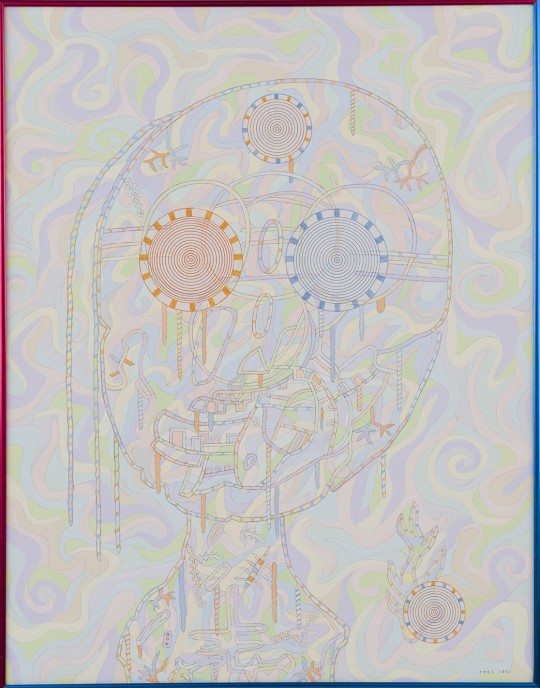
Shinjiro Okamoto (1933-2020) — Female Ghost from Yotsuya Kaidan [acrylic on canvas, 1985]
96 notes
·
View notes
Text

Yotsuya Kaidan (四谷怪談), ukiyo-e by Utagawa Kuniyoshi
The story of Oiwa and Tamiya Iemon is a tale of betrayal, murder and ghostly revenge. Arguably the most famous Japanese ghost story of all time, it has been adapted for film over 30 times and continues to be an influence on Japanese horror today. Written in 1825 by Tsuruya Nanboku IV as a kabuki play, the original title was Tōkaidō Yotsuya Kaidan (東海道四谷怪談, Ghost Story of Yotsuya in Tokaido). It is now generally shortened, and loosely translates as Ghost Story of Yotsuya.
First staged in July 1825, Yotsuya Kaidan appeared at the Nakamuraza Theater in Edo (the former name of present-day Tokyo) as a double-feature with the immensely popular Kanadehon Chushingura. Normally, with a Kabuki double-feature, the first play is staged in its entirety, followed by the second play. However, in the case of Yotsuya Kaidan it was decided to interweave the two dramas, with a full staging on two days: the first day started with Kanadehon Chushingura from Act I to Act VI, followed by Tōkaidō Yotsuya Kaidan from Act I to Act III. The following day started with the Onbo canal scene, followed by Kanadehon Chushingura from Act VII to Act XI, then came Act IV and Act V of Tōkaidō Yotsuya Kaidan to conclude the program.
The play was incredibly successful, and forced the producers to schedule extra out-of-season performances to meet demand. The story tapped into people’s fears by bringing the ghosts of Japan out of the temples and aristocrats' mansions and into the home of common people, the exact type of people who were the audience of his theater.
source
#yotsuya kaidan#ghost story#japanese folklore#japanese ghost story#ukiyo-e#kabuki#utagawa kuniyoshi#japan art#japan#japanology
53 notes
·
View notes
Text
Recently Viewed: Kenji Misumi’s Yotsuya Kaidan (1959)
[The following review contains MAJOR SPOILERS; YOU HAVE BEEN WARNED!]
Yotsuya Kaidan is Japan’s most popular and frequently adapted ghost story. While the core premise is basically consistent from version to version—penniless ronin Tamiya Iemon falsely accuses his wife of adultery as a pretext to divorce her and marry a wealthier woman, culminating in violence, regret, and vengeance from beyond the grave—the precise details of the narrative vary wildly between cinematic interpretations.
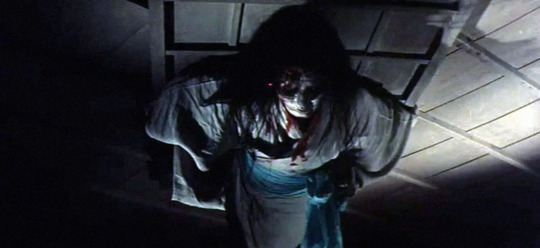
Shintoho’s 1959 film (helmed by Jigoku director Nobuo Nakagawa), for example, is a relentlessly dark (albeit vibrantly colorful) and bleakly cynical morality play; the protagonist is casually cruel and unrepentantly vile, with his grisly fate framed as karmic justice that the audience is intended to enthusiastically applaud. Keisuke Kinoshita’s 1949 duology, on the other hand, depicts Tamiya far more sympathetically; despite his (thoroughly reluctant) complicity in the terrible crimes committed against his spouse, he’s motivated primarily by economic factors beyond his control and the corruptive influence of his slimy, manipulative, verminous “friend,” Naosuke. Indeed, it is implied that the “haunting” is merely psychological—a subconscious manifestation of the central character’s guilty conscience. (Ironically, this “social realism” makes Kinoshita’s movie feel more subversive and revolutionary than Nakagawa’s comparatively lurid and gory effort.)
Kenji Misumi’s radically revisionist spin on the classic tale, however, probably takes the most liberties with the surprisingly malleable source material. Here, Tamiya (played by megastar Kazuo Hasegawa—which goes a long way towards explaining the particular “quirks” in his portrayal) is borderline heroic—an archetypal gruff-yet-chivalrous swordsman cut from the same cloth as Zatoichi and Tange Sazen. He’s also so passive and devoid of agency that he resembles the eponymous “specter” in Hammer’s The Phantom of the Opera, remaining virtually blameless for the (unnecessarily convoluted) series of events that result in his tragic downfall. He’s totally unaware of Naosuke’s devious conspiracy to humiliate, defame, and ultimately murder his wife, and although he still participates in an extramarital affair, the relationship appears to be purely transactional (and may not be overtly sexual; the extent of the “lovers’” physical intimacy is left deliberately ambiguous)—driven to desperation by poverty, he only indulges his mistress’ affections in exchange for money and lavish gifts. The editing, in fact, at one point explicitly juxtaposes his infidelity with that of his sister-in-law, who works part-time as a “waitress” at a “bathhouse” in order to supplement her husband’s meager income. Naturally, Tamiya’s relative “innocence” completely recontextualizes the story’s climax and denouement; whereas the character usually suffers an appropriately shameful, pathetic, undignified demise, Misumi allows him to achieve a measure of redemption via his glorious, honorable, beautiful death—sprawled at the feet of a bronze Buddha statue, wrapped in his wife’s favorite kimono, bathed in heavenly sunlight.

Pulpy, unsubtle, and unapologetically melodramatic even by Daiei’s standards, Yotsuya Kaidan isn’t the “best” adaptation of the original kabuki production, but Misumi’s various audacious departures from the “traditional” formula certainly distinguish it as one of the most interesting, unique, and undeniably compelling. For fans of chanbara and J-horror alike, it is essential viewing.
#Yotsuya Kaidan#Yotsuya Kwaidan#Ghost Story of Yotsuya#Kenji Misumi#Kazuo Hasegawa#Daiei#Japanese film#Japanese cinema#Japanese horror#J-horror#J horror#chanbara#Film Forum#chambara#film#writing#movie review
0 notes
Note
(this is spacekrakens lmao) dude idk anything about like 1950s Japanese cinema, do you have any recommendations? looking for stuff to toss on the watchlist now that I'm a bit burned out on horror (unless you have some horror recs)
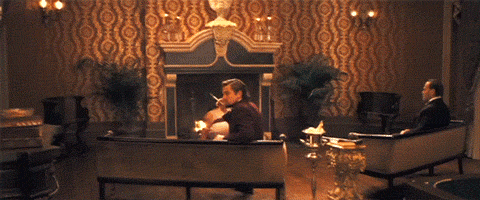
Hey! If you’re curious about Japanese cinema (particularly 1950s), there’s a lot of avenues to explore! Musicals, crime, horror, historical—it all depends on what mood you’re in. (Putting this under a read more because I'm DEFINITELY going to be long posting about this!!!) Hope this is useful to you lol.
(Also noting if anybody wants to add to this list with their own recommendations feel free!!)
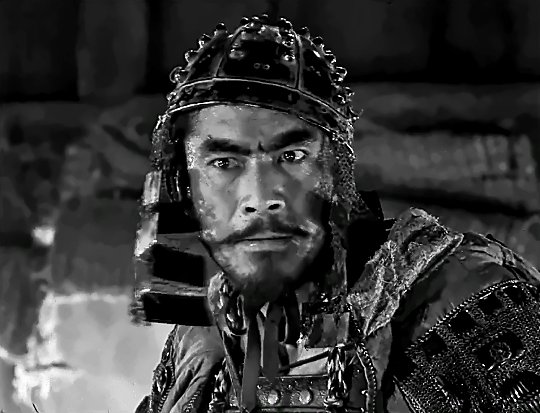
With old school Japanese cinema, I’ll always recommend Akira Kurosawa (obviously). He’s made some of the best Japanese movies (and arguably, the best movies of all time imo) and I feel like his work is a good gateway. It’s readily available on physical media/streaming too.
Specifically ‘50s stuff; Hidden Fortress (1958) is a good adventure flick whose structure was swiped for Star Wars, Throne of Blood (1957) is Japanese Macbeth if you like Shakespeare, and if you don’t mind a longer movie Seven Samurai (1954) includes Toshiro Mifune acting like this;
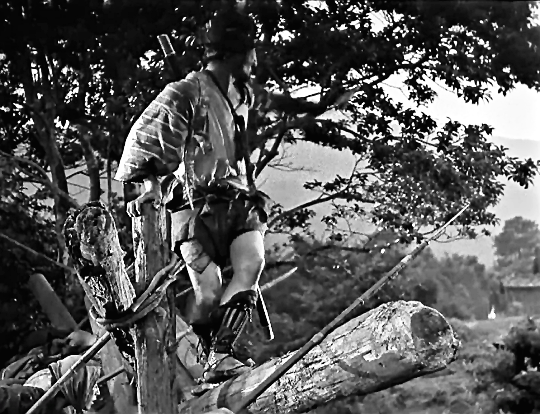
Gotta admit, though—my personal favorites from Kurosawa don’t come from the 1950s; Drunken Angel (1948) and Yojimbo (1961). One has a pathetic gangster as the main lead, the other is just a solid, breezy proto-action film (also has my beloved Unosuke but that's besides the point)
Some personal favorites of mine from the 1950s:
Life of a Horse Trader (1951) is a bittersweet story about a man trying to be a good single father to his son in the backdrop of Hokkaido. He tends not to be great at it. Stars Toshiro Mifune, the most famous face of Japanese cinema and for good reason!
Conflagration/Enjo (1958) is a single Buddhist acolyte’s fall into quiet insanity. Raizo Ichikawa is another amazing actor who I love! Also includes Tatsuya Nakadai who is the GOAT (in my heart).
Godzilla (1954) is AMAZING! If you liked Gozilla Minus One, it took a lot of familiar cues from this movie. It also technically counts as horror, depending on your definition.
Japanese horror from the 1950s:
Ugetsu (1951) (Not one I’ve seen personally, but it’s on Criterion)
The Beast Shall Die (1958) (American Psycho, but in Showa Japan. Tatsuya Nakadai is terrifying in this and absolutely despicable—stylish movie tho!)
Ghost of Yotsuya (1959) (Old-school Japanese ghost story. Honestly, there are so many different versions of this story on film that you can pick which version to watch and go from there—I’m partial to the 1965 version myself, because of the rubber rats and Tatsuya Nakadai playing a crazy person).
The Lady Vampire (1959) is the OG western-style vampire movie from Japan. Plays around with the mythos a lot, but hey our Dracula looks like this;

Misc movies that I think are neat or good gateway movies:
The Samurai Trilogy by Hiroshi Inagaki, which stars Toshiro Mifune as Miyamoto Musashi. Found that people otherwise uninterested in Japanese cinema really enjoyed this!
You Can Succeed, Too (1964) is one of my favorites from the ‘60s, also directed by Eizō Sugawa. A fun satire on the corporate world that's super colorful with catchy songs.
The Sword of Doom (1966) is also another favorite of mine, starring my beloved Tatsuya Nakadai as another bastard man (seriously though Ryunosuke is FASCINATING to me--). Fun gore effects and action scenes!
Kwaidan (1964) is an anthology of Japanese folk tales, labeled a horror film but in that kinda sorta old-school way. Beautifully shot by my favorite Japanese director Masaki Kobayashi (who, if you like this you should seriously check out his other work!)
#thanks for the ask!#akira kurosawa#tatsuya nakadai#toshiro mifune#raizo ichikawa#japan#film#godzilla#hidden fortress#seven samurai#drunken angel#yojimbo#enjo#sword of doom#kwaidan#you can succeed too#samurai trilogy#the lady vampire#ghost of yotsuya#ugetsu#life of a horse trader#throne of blood#ask
70 notes
·
View notes
Text

筑波鳥兜[Tsukubatorikabuto] Aconitum japonicum subsp. maritimum
筑波[Tsukuba] : 筑波山[Tsukuba-san], Mount Tsukuba https://en.wikipedia.org/wiki/Mount_Tsukuba
鳥兜[Torikabuto] : Bird helmet, a traditional hat worn in Bugaku; wolfsbane, the genus Aconitum https://www.metmuseum.org/art/collection/search/55104
It is a subspecies of 山鳥兜[Yamatorikabuto](A. japonicum subsp. japonicum) and so named because it was first found in Mount Tsukuba, Ibaraki Prefecture. Compared to Yamatorikabuto, it has more deeply lobed leaves and the longer flower helmet, apical sepal. However, since the two are extremely similar, I am not confident in this identification.
Torikabuto is one of the most poisonous plants in our country. The entire grass is poisonous, especially the roots. The main component of it is aconitine. While this is used as a medicine, poisoning deaths from accidental ingestion and homicides have also occurred. It is said that this is probably what Iemon gave to Iwa in the ghost story Yotsuya Kaidan.
14 notes
·
View notes
Text
Okay, so the latest chapter of Mieruko-Chan (Chapter 56) has set up three (3) things. There are spoilers in here, but this chapter was less big plot and more build up for characters and later plot.
1. Michiru and the Caterpillar Forest Spirit are still integrating
Michiru is still very Michiru, but the tentacles are goofy now. Probably because she doesn't feel like she has to be defensive or aggressive in having a friend, so the caterpillar forest spirit seems to have relaxed some. Why it's being so goofy is not yet seen but I'm not complaining. It looks like Michiru is still insecure of her place as Hana and Miko's friend (could be the cause for the goofy. She's trying to "unwind with friends"), and she's still adamant on Miko particular, but she's also interacting with Hana and is less forceful when Miko turns her down. Miko is also far less worried about the spirit (now that she knows what it is and Michiru's situation), and even considers the spirit a logical option for dangerous spirits, but isn't keen to bother Michiru with these situations. It's a process, Michiru with the group, and a good one to be seeing.
I also liked Zen-sensei's smile while seeing them goofing around. He definitely became a teacher with the mind to take notice of students in similar situations to him and act where and when he could, as we saw with Michiru's. Even if her situation was very different his "interference" was still needed. Michiru and You couldn't stay in a bubble forever.
2. The shadow
This was one of those suited shadows from the end of ch. 55. We aren't sure if these are spirits or something completely different.
These are clearly being built into an arc, but what they are for we don't yet know. These dudes and the main guy who seems very aware of Romm (and may be the Seto who Romm was going to contact but I've experienced a moment like this where characters you thought were built to be the same person turned out to be completely seperate). I'm wondering if these guys are attached to the caterpillar spirit story, cause it almost seemed like they were visiting the Caterpillar spirit's shrine which they found broken. However, I could be wrong and this is a completely different shrine. Maybe it could be linked towards Romm's near death experience we saw, or the as yet unresolved "WHAT THE HELL CAME OUT OF THE MOUNTAIN" from the end of the mountain shrine story, or something else entirely.
Altogether, they're around, they're probably going to be part of something important, and one is tailing Miko. Question is: Is it because she interacts with Michiru and the Caterpillar Spirit, or because she interacts with Romm? (And are they aware that she can see? That's a good question too, but I'm leaning towards "no and they'll just be mildly surprised she can".)
Initially when I saw the one tailing Miko, I thought it was another shape for the "photo guy" and have sense slapped my forehead realizing it wasn't. But I wonder if they might be something to get involved with the photo guy situation (I'm feeling very "each photo it appears in it grows closer" lurking death type). It did almost kill Romm after all and he's contemplating help from someone, but again I'm 50/50 on if it's actually the same person we saw in the manga.
3. Dad
On to our favorite household duo. Dad has shown he might not be around for an big reason, but he's definitely around to look after his family and that includes dangerous spirits that can latch onto and hurt the living. We have seen the first one actually capable of doing so, because it grabbed onto Kyoya with harmful intent.
A lot of people think that weird horse-dog looking ghost in the Yotsuya household may be another half of the dad, or it could be a guide for him in the way that creepy wheelchair dude that wheeled the recently deceased old man from the hospital away with his family. Either way, this entity has yet to be shown as dangerous (just unsettling for Miko) and the dad's ghost interacts with it casually. We also don't have a truely clear answer as to why dad or horse/dog spirit is still here.
However, in this chapter, we see dad is able to stand his ground against creepier entities, telling them clearly to leave, and the horse/dog acts as a sort of "guard dog" that will act if the problem doesn't back down.
Dad is sticking around to protect his family, and the other ghost is acting the same. We were lucky this spirit didn't seem to be
But, if I'm not mistaken, WE STILL DON'T KNOW WHAT THAT ONE GHOST OUTSIDE THE DOOR THAT ONE NIGHT WAS. I thought it was going to be linked to Michiru and You, but, with retrospect, I'm wondering if it was only imitating You. Knock and say a thing to get someone to answer the door. This interaction was tense due to the situation with Michiru, but I think it was setting up that Dad can tell the good from wrong sort.
Which could have been an important moment considering the interaction between the caterpillar spirit, the horse-dog and Dad. Dad didn't seem to have much self(ghost self?) preservation with the caterpillar spirit, who was acting out of over protectiveness due to Michiru's mental state. And it was the horse-dog that de-esculated that situation, considering it had caused it. This could be due to the separation of ghosts from something like guides and the strength of forest spirits (assuming again that horse-dog is a guardian type). Maybe Dad didn't clock the danger because it's a spirit attached to a living girl. Maybe he follows the horse-dog's lead of danger vs okay. Maybe he just didn't see a threat because he could recognize it for what it was and it was the equivalent of trying to approach a chihuahua (they can lash out or become putty and its a coin toss sometimes). There's options, probably more than what I came up with.
18 notes
·
View notes
Text
Ayakashi: Samurai Horror Tales--Yotsuya Kaidan
I don't think I liked this as well as I liked the other story! The other story was much more my speed despite me yelling at the two main characters. (And I will continue) There's a musical theme that runs through the stories--I'll try to find it when I'm doing the third story so you can hear it--and it fits better with the first story, it's really quite beautiful.
This is a ghost revenge story, and it's not bad at all, but it does have a couple places where you have to simply accept the gaps in the logic (a body double? Come now) and basically poor Oiwa, of course she comes back as a ghost, Iemon is terrible, but it is 100000% about the dude and whatever. Did not do anything for me. I wanted to like it more than I did. I'd watch the first one again, but not this one.
BUT. I LOVED the framing device. So the framing device is a playwright, and he's talking about this play he wrote, and how it differs from the opther versions of the stories you might have heard, and he leaves it up to you how much is true of any given version, weaving in real life places and happenings in japan. I wanted more of this than I did of the actual story!
7 notes
·
View notes
Text
Hirano to Kagiura light novel translation 4-1
Chapter 4: Fall.
Part 1
Prev || Next
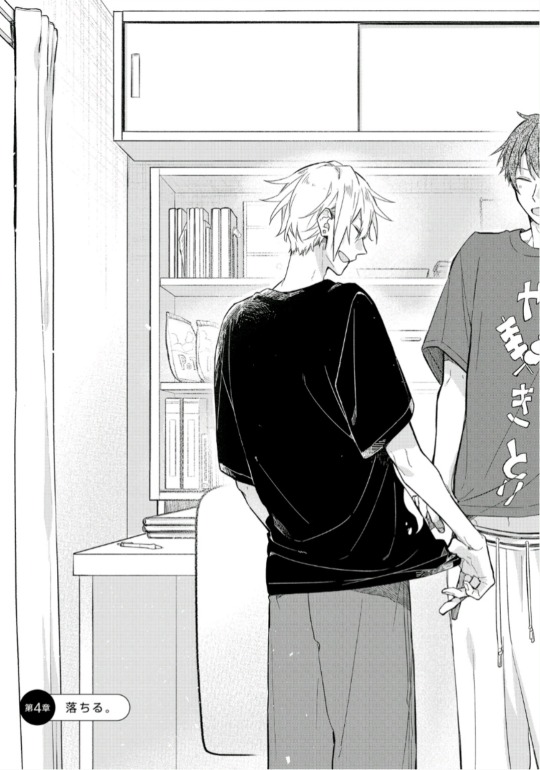
It might be September by now, but the sun’s rays know no bounds.
Heat from the weather aside, the schoolhouse on the coattails of summer break is permeated with the fervor of the students.
Among all those in the athletic clubs who have undergone away games and training camps, there are many who have deepened both their tans and their virility. The sense of achievement characteristic of those who kept up with their exercise lives within their growth spurts.
Hirano’s roommate is, once again, one of them.
Kagiura, who’s gotten a bit taller, has gotten used to high school, completely devoid of the anxiety he’d seemed to have around the time he’d started school.
Since they’d met up over the summer, he’s become more and more relaxed, and Hirano can’t help but think of him as a beloved younger brother.
Wait, but younger brothers don’t do things like give you earrings, do they?
Hirano isn’t really in a position to judge, with no siblings of his own.
He’d found his original earrings while organizing his luggage after returning from Kagiura’s countryside home. They’d fallen into his school bag and hidden themselves beneath the stiff bottom plate.
What should I do about it? he’d wondered, but figured well, whatever, and didn’t bother switching out his new ones. He’ll keep them in the dorm just in case, but ultimately plans to keep using the ones Kagiura gave him.
As soon as the new term starts, preparations for the Cultural Festival are full speed ahead. Even the first years, who aren’t used to running events without the guidance of a faculty member, are gradually gaining opportunities to build character. The Executive Committee members have so many responsibilities that it has become difficult to carry out their studies without the cooperation of their classmates.
Kagiura also has the situation of being part of the ‘Sports Recommendation Squad’, and his grades are not up to snuff. It would be good if they don’t take a hit from his extracurricular responsibilities, but that will come down to his own efforts.
It’s not just the Executive Committee members who are swamped. The students in the culture clubs are also at their busiest, and with the autumn tournament right around the corner, there’s no way the athletics clubs can cut back on practices.
The sweltering nights have yet to abate; yet despite these conditions which could even be called cruel, most of the students are eagerly awaiting the Cultural Festival. You might even get away with saying all of them.
Because, after all, girls come to visit the cultural festival.
And even without that element, a festival is still a festival.
This is a time when the whole student body is restless, so the Disciplinary Committee will be on top of keeping everyone in line—or such is their public stance, but they won’t be too strict about moderating uniforms and hair styles.
In any case, a high proportion of the students will be in costumes on the day of the festival.
There's also at least one class cross-dressing every year.
This year, that’s right, it's the class that Hirano is unfortunately a part of. More specifically, it's been decided that Hirano will be one of the ones in drag.
Oiwa-san—a famous spirit who makes an appearance in the Yotsuya Kaidan.¹
There are many variations of the famous ghost story, in which Oiwa, the deceased wife, holding a grudge over the betrayal of her husband, Iemon, slaughters every last person involved. Apparently, they will be basing the makeup off of Tōkaidō Yotsuya Kaidan², which is popular among Hirano’s classmates.
He’d been shown reference images of the ghost, her face half disfigured and inflamed by poison, but the picture was nightmare fuel when viewed in the dark.
Supposedly it’s a style of Halloween makeup that’s been popular in recent years, but the trial makeup that had been applied to his arm after school in order to match the shade to his face had been truly grotesque.
This information is to be kept top secret until the last possible minute on the day of, in the interests of building hype.
While Hirano is putting away his homework, the door opens with a click.
His roommate is home.
It’s still bright outside, but the dining hall is just about to open for dinner.
“Hirano-san, I’m home!”
“Welcome home, Kagi-kun.”
These days, Kagiura usually gets a bit bashful in reply to Hirano’s greeting, seemingly tickled. So naive and innocent he must be, making such an expression with no fear of being misunderstood.
There were days they’d spent together, but summer vacation had been long.
There’s an air of a different kind of newness from the one there’d been in the period before they’d gotten used to sharing a dorm—Kagiura probably feels it too. At least, Hirano thinks so.
He feels closer to Kagiura compared to before. After all, he’s met his immediate and extended family, so of course they’d feel more intimate. It’s as if the part of himself that had been on guard while thinking about how to act as a senpai in his second year in the dorms has been absolved.
After Hirano had filled out his print-outs as if in competition with Kagiura, who’d spread out his homework in a frenzy, they’d headed to the dining hall a little later than usual.
It always takes him about 3 or 4 days to get back into the swing of dorm life.
Speaking of which, he thinks.
Before Kagiura moved into the dorms, Hirano had been quite nervous.
He’d talked to Hanzawa about it one time when the Disciplinary Committee had a meeting, and they’d brainstormed strategies to avoid scaring Kagiura off.
He’d also felt it would be a waste of his efforts if he was only friendly at the beginning of their time spent living together; thus, they’d come to the conclusion that it wouldn’t be too far out of Hirano’s depths to give him a nickname and use “-kun”.
Oh yeah, that’s right. At the beginning I called him Kagiura-kun.
He’s been calling his name every day, enough that he’d ended up shortening it, thinking it’s too long and clunky.
Kagiura has morning practice tomorrow, too, so there's no way he can let him oversleep.
Hirano got that, but there was something on his mind that just wouldn’t go away, so he asked before shutting off the lights.
".....Hey, um. I know you're working hard, so I don't wanna rain on your parade, but are your studies going all right? I haven't heard how your proficiency test went yet."
As the words leave his mouth, he thinks, what am I, a private tutor? and laughs drily to himself.
For the results of the test held right after summer break, a list ranking every student in their grade and the standard score were passed out to each person, the same as for the periodic exams.
For first years, they can be used as nothing more than a reference, but due to the breadth of the material covered, in some cases they might be used to determine which schools to apply to when compared to results from previous cram schools.
“...I just barely passed.”
“What’s the damage?”
“The teacher said, ‘You didn’t do badly enough that I need to pull you aside, but keep working hard’...”
“I see.”
Which is bad in and of itself, really.
Kagiura hangs his head dejectedly, and Hirano’s tempted to comfort him all the more for having seen the extent of his efforts, but his lack of preparation is unmistakable.
“Kagi-kun, after the cultural festival is over, you gotta step it up. If you miss some of the notes, get someone to show you theirs before the next day. Don’t let them build up. If you end up with a backlog of notes to take, you’re not gonna be able to understand them.”
Hirano knows deep down he’s probably worrying too much, but he keeps the expression on his face stern. The beginning is the key to everything. Among his classmates in the ‘Sports Recommendation Squad’ who, like Kagiura, are bad students, there are many whose grades plummeted after going on to their second year.
Who knew he’d become this much of a worrywort after becoming someone’s senpai?
“Yeah…Hirano-san, will you teach me again?”
“Sure. But you better bring back good grades.”
“I will! …By the way, can I ask you something?”
He ducks his head as he asks the question, a gesture with all the charm one would expect from someone as cute as him.
“What’s up?”
“When you were a first year, did the senpai you roomed with teach you how to study, too?”
“Nah, no way.”
“Hm…did you not get along?”
“It’s not that we didn’t get along, we just weren’t really that close. I wasn’t nearly as friendly a kouhai as you are.”
This is usually the case for dorm students. Hanzawa, contemptuous of homosexual relations, has a reputation in certain circles for having a finely-tuned gaydar and showing up to cockblock any time he senses anyone getting a little too close.³
His distaste isn’t unwarranted; apparently it has to do with his family, so even Hirano feels bad for him.
“...Does that make me special, then?”
“Why are you so happy about that?”
At Hirano’s jests of what are you, a dog? Kagiura breaks into a grin.
“Yeah. You know, I’m glad I’m your roommate, Hirano-san.”
Hirano smiles wryly; Kagiura’s got him wrapped around his little finger without a hint of insincerity.
With Kagiura cozying up to him like this, he doesn’t stand a chance.
*****
T/N: (1) Not sure I need to add more info on this to the story, but it's pretty interesting, so you can read more about it here.
(2) A movie based on the story made in 1959.
(3) Yall....idek what to say about this. I tried to keep the tone lighthearted but the original text literally says 'gay-hating Hanzawa' and describes his feelings as disgust. Idk why the writer put this but our boy is NOT like that 😭 I actually broke my vow of not looking at the official TL just to see how they handled this bit and they completely watered it down lmao. and tbh, yall know my dedication to accuracy but I WAS TEMPTED. While going back and forth about what I should do, I told my sister about it, and she suggested that Hanzawa doesn't actually hate gays, he just hates gay sex and will stand for none of it in his dorm so...we're going with that interpretation 💀🙃💀🙃
Prev || Next
Special shoutout to @jeizet, @jujupanic, @massyworld, @umbreonwolfy, and @acidsuzanne-blog for sponsoring these updates 🙌
#you guys can reblog these posts btw <3#remember likes are great but they don't do anything to spread the posts around!#friendly reminder that tumblr is not ig/tt and we love her for it <3#re 3rd footnote: im still trying to cope#im really hoping that the 'homophobic' and 'disgust' etc are referring to his reputation rather than his real feelings#tho i'm not sure that's much better 💀#also im sorry but wtf is up with the whole 'its to do with his family so hirano feels bad for him thing'#like??? oh poor you your sibling is gay that must be such a struggle#guess you have the right to hate gay people. ??????#this makes it sound like there was some TRAUMA involved#but it was literally just his brother (and other sibling) saying btw im gay and then they all moved on with their lives??#shoutout to my sister for this slightly inaccurate but much better take#i told her about it and she was like 'nah this mf just repressed as hell 💀'#she does not read ssmy/kghr btw#hirano to kagiura#hirano and kagiura#kagihira#hirano to kagiura light novel#hirano to kagiura translation#harusono shou
136 notes
·
View notes
Text
Ikigusare - Oiwa-san Rock
The song, the lyrics (with an english translation by me) and some commentary are below.
youtube
Japanese, directly from the subtitles in the video:
映画 お芝居やるのなら お参りしないと祟られる お名前 口にするのなら 敬称つけぬと祟られる
そんな猛烈な呪い お江戸の時代から 今この現代まで ずっと続いてるなんて
なんて凄まじい情念でしょう なんて素晴らしい怨念でしょう どうすれば貴方様のようになれるのかしら 誰か私に毒を盛って
鏡の前 髪をすくと ズルリ ゴッソリ 抜け落ちる ご遺体 釘付けされた 戸板 川に浮かび上がる
そんな恐ろしい場面 ひどく陰惨な場面 そんな時も貴方様 お美しいのですね
なんて凄まじい情念でしょう なんて素晴らしい怨念でしょう どうすれば貴方様のようになれるのかしら 誰か私に毒を盛って
なんて凄まじい情念でしょう なんて素晴らしい怨念でしょう どうすれば貴方様のようになれるのかしら 誰か私に毒を盛って English:
Filming a movie, writing a play, Visit her grave, or you'll get cursed. Saying her name, Address her properly, or you'll get cursed.
Such a powerful malediction, dating back to the Edo times, They say it still goes strong to this day.
Such great passion, isn't it? Such wonderful hatred, isn't it? Ah, what must I do to become like you? Somebody, give me that poison!
In front of the mirror, you're combing your hair. It's so loose that it falls out completely. A corpse nailed to a board Rises to the river's surface.
What a horrific scene, what a scene of terrible despair. Even in such a moment, you are more beautiful than ever...
Such great passion, isn't it? Such wonderful hatred, isn't it? Ah, what must I do to become like you? Somebody, give me that poison!
Such great passion, isn't it? Such wonderful hatred, isn't it? Ah, what must I do to become like you? Somebody, give me that poison!
Commentary (explaination + personal thoughts):
Obviously, this is referencing Yotsuya Kaidan, a classic japanese ghost story and kabuki play. I suggest reading or watching a retelling of the story to get the whole context. This is what you'll need to know to understand the lyrics... Basic: Oiwa is the main character of Yotsuya Kaidan. The story isn't very consistent between its different versions, but the gist is that her husband Iemon betrays her and her family in several ways, mainly by killing her father and then having an affair with a different woman. That woman later poisons Oiwa so that Iemon can marry her instead. When Oiwa dies, she becomes a vengeful spirit and torments Iemon. This is a very basic summary of her part in the story. Verse 1: There's a belief that when making an adaptation of Yotsuya Kaidan, be it a movie or a stage play, the cast, crew and other creators should visit Oiwa-san's grave and shrine and ask her to bless their production, lest her curse befall them. The part about adressing her properly isn't anything I recognise, but I imagine you'd have to be pretty polite when talking to a vengeful spirit who may curse you. Bridge 1: The story is set in the Joukyou era (~1684-1688) and loosely based on an incident that happened in the Genroku era (~1688-1704), which are eras in the Edo period (1603-1868). The play was written in 1825. Chorus: Oiwa was tricked into disfiguring herself with a poisonous facial cream. That's the poison being sung about. Because of it, her eyes started drooping and her hair partially fell out, among other things. Her disfigured face is particularly iconic, especially how Iemon kept seeing it everywhere after her death. Verse 2: Lines 1-2: In the play and in adaptations, there is usually a scene of Oiwa combing her hair in front of a mirror and it falling out from the poison. From what I know, the scene is a tragic and horrific play on a type of sexy fan-service scene in kabuki plays where a beautiful woman combs her long hair. Lines 3-4: When Oiwa eventually dies (either from the poison, from despair or from both), her body is nailed to a board and dumped into a river by her husband. Later, when he's trying to fish, he catches her, nailed to that board.
Anyway, I really like this song. It sounds gentle and romantic, even though it really isn't. I like the traditional japanese feel it has despite (to my knowledge) not having any straightforwardly traditional musical elements. Ikigusare is kind of hit-or-miss for me musically, but when it's a hit, that song quickly becomes one of my favourites. The lyrics are rather nice and well-written, though I can't help but feel like some of them are pretty generic. The visuals, though, are spectacular every time and I have nothing bad to say about them. The low-poly music videos add so much surrealism and mistique to the songs, a lot of which wouldn't be very remarkable in a different entourage. The girls' stilted dancing and position switching only adds to that surreal feeling. The girls themselves have amazing designs, very simple and striking. The one-two-three eyes pattern, their image colours being very basic and distinct (RGB, literally), their constantly changing themed outfits and the unique slightly grotesque twist on a common idol persona look that each girl has make them work very well as a unit, especially a horror-themed one. Overall, a rather interesting group/artist. I have at least four Ikigusare songs that I want to translate and post. I'll do it at some point in the near future if nobody beats me to it.
#own post#own translation#translation#music#ikigusare#ikigusare idols#yotsuya kaidan#japanese folklore#my first attempt at something like this#to my knowledge nobody has translated this yet#feedback is welcome
23 notes
·
View notes
Note
Please infodump to me about Oiwa :D{
AHHH okayyy
I don't know MUCH about Oiwa, but from what I can see, I believe she's a Japanese Ghost Story if a woman coming back from the dead to haunt her husband who had betrayed her until he went insane

This was the bust of her sent to Disneyland from Japan when they were searching for ghosts to put in the mansion n all
She was rejected ofc but they kept the bust around
This is some more reading on the actual backstory in her if you want heh
#haunted mansion#ask#the haunted mansion#disney haunted mansion#thanks for the ask#oiwa#aquilacalvitium#tw face injury#just in case
21 notes
·
View notes
Text
As Kaz stumbled down the Market, chest weeping sticky blood, he felt himself smile. Sharp, dangerous, but with a newfound glee bubbling within him. He popped the safe end of the smudged incense between his lips as he reached out for the stall closest to him. He swiped a leaf of wax paper, folding Oiwa’s old silks and wrapping them in the paper as he kept walking forward. At the next stall he casually unspooled a length of twine, angling it against the sharp edge of the counter so it would snap and tail behind him obediently. He wrapped the bundle efficiently as he walked, until he had reached his newfound destination.
“Dolinde,” He called out, removing the spent incense stick and tucking it under the straps of the tied package with a flourish, “I need you to make a delivery.”
“I’m working, bossman,” Dolinde, a freshly fourteen-year-old Zemni girl, retorted. She ran a bustling stall selling shortbread at the end of the West Stave. She was a talented baker, specializing in sweet pastries and bread that melted in your mouth. Flakey, warm and fresh. Matthias was obsessed with all of her baked goods, and made Kaz stop frequently whenever work took them close to the West Stave. As such, Dolinde became an honorary Dreg of sorts. She was a shrewd business woman who always bargained hard and networked harder. She spoke eight languages roughly, and five of them fluently.
“Make time for me, and I’ll make it worth your wild,” Kaz shrugged.
“Oh please. With what, your little pocket drüskelle? Newsflash, his labor is free now, he comes to help me make deliveries of his own volition,” Dolinde said haughtily, “You have nothing to offer me. I don’t want your money, and I don’t need your labor.”
“Not even if the delivery is at the bequest of the Ghost King?” Kaz raised an eyebrow, already knowing he had won. More than anything, Dolinde loved rumors. He had wrangled many a favor out of her in exchange for ghost stories and torrid gossip. With this newfound talk of a Ghost King, she must have been frothing at the mouth for more details. Details that he was sure he could provide, if she were willing to cooperate.
Dolinde scowled, eyes narrowing, “Talk of the King of Ghosts only surfaced this morning, and you already claim to be working for him?”
“Working with him,” Kaz corrected, “I don’t work for anybody. So, are you interested or not?”
“What’s the delivery?” She asked skeptically, but Kaz could see she was practically vibrating with excitement already.
“This goes directly to Tante Heleen herself,” Kaz said, handing over the bundled package, “Compliments of the Ghost King and his malevolent shadow Tamiya Oiwa.”
Dolinde’s eyes bulged in shock, “So the Ghost King really did tame the Shadow of Yotsuya?”
“She tamed him, so I heard,” Kaz smiled knowingly. “Will you deliver it or not?”
Dolinde studied the package for a moment, eyes picking up every detail available, “Yeah, sure, I’ll deliver it. Payment’s the usual?”
“There’ll be a stool waiting for you at the Six, and if you bring something baked I’m sure Jesper will add a glass or two of Amasi to your payment as well,” Kaz nodded, “I’ll give you just about every detail I know. But give me at least a day before you hound me for details. I have business to attend to first.”
“The deal is the deal,” Dolinde said with a mock salute, tucking the package under the counter of her stall. By the end of the day it’ll be back at the Menagerie, hopefully driving Tante Heleen positively nuts. Kaz delighted at the thought of it.
(Sequal to The Shadow of Yotsuya coming soon on Ao3!
In the meantime, read The Shadow of Yotsuya here - https://archiveofourown.org/works/48130705)
#six of crows#crooked kingdom#grishaverse#soc ck#kazzle dazzle#kaz brekker#six of crows fandom#six of crows fanfic#polycrows#ao3 fanfic#ao3 link#ao3 writer#ghost fic#spooky#spooky season#halloween#jesper fahey#soc jesper#matthias helvar
26 notes
·
View notes
Text
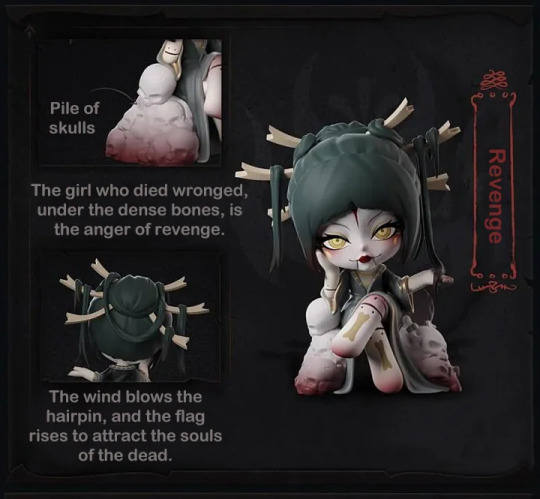
From the Kayla X “Legendary Spirits” blind box collection:
Her name is Revenge.


Revenge is an onryō, a vengeful spirit of Japanese folklore. Her long flowing black hair and pale face match the traditional depiction perfectly, though her dress is a dark bluish-gray rather than the traditional white burial kimono that onryō are usually depicted in.
The bones(?) in her hair led me to a story from the Konjaku Monogatarishū, a collection of folktales. The story is titled "How a Man’s Wife Became a Vengeful Spirit and How Her Malignity was diverted by a Master of Divination", which I assume is more succinct in the original Japanese. It's a story about a woman who is abandoned by her husband and dies in their home, but remains as an onryō, with her long black hair continuing to grow, and her skeleton remaining whole. Eventually the husband is forced to return to deal with his dead wife, and he grabs her hair and rides her around the countryside like a horse until she collapses to dust in the morning.
Wild stuff, though I believe Revenge here is meant to be a more general depiction of an onryō than a specific character. The lack of a white burial kimono is throwing me off, but it may be that these figures are sold to a largely Western audience who associate black as the color of death and mourning, so that's what they went with. She does have a very Western-looking gravestone behind her back, amid the pile of skulls, which I think is jarring as well. I don't actually know what the target audience of these kinds of figures are though, so I could be completely wrong.
I also wanted to mention the most famous onryō, because if you've ever seen this image:

then you need to know that this is Oiwa, perhaps the archetypal onryō, from an 1825 kabuki play called Yotsuya Kaidan, which has been adapted countless times. Basically, through a series of betrayals and deceptions, the samurai's wife Oiwa is scarred and mutilated and dies trying to kill her deceiving husband, coming back again as a wrathful spirit who torments him and tricks him into committing more murders. For a reason I'm not totally sure of this very famous painting of her depicts her as a broken paper lantern spirit, notably with a distorted face and eyes from her scarring.
I'll throw in a link to the ghost story of Okiku as well because it's sad as hell and another example of an iconic onryō, though this one is more sorrowful.
Sources:
3 notes
·
View notes
Text

Yotsuya Kaidan (四谷怪談) - ukiyo-e by Katsushika Hokusai
Oiwa is an onryō, a ghost who seeks vengeance. Her strong passion for revenge allows her to bridge the gap back to Earth. She shares most of the common traits of this style of Japanese ghost, including the white dress representing the burial kimono she would have worn, the long, ragged hair and white/indigo face that marks a ghost in kabuki theater.
There are specific traits to Oiwa that set her apart physically from other onryou. Most famous is her left eye, which droops down her face due to poison given her by Iemon. This feature is exaggerated in kabuki performances to give Oiwa a distinct appearance. She is often shown as partially bald, another effect of the poison. In a spectacular scene in the kabuki play, the living Oiwa sits before a mirror and combs her hair, which comes falling out due to the poison. This scene is a subversion of erotically-charged hair combing scenes in kabuki love plays.[3] The hair piles up to tremendous heights, achieved by a stage hand who sits under the stage and pushes more and more hair up through the floor while Oiwa is combing.
Oiwa is supposedly buried at a temple, Myogyo-ji, in Sugamo, a neighborhood of Tokyo. The date of her death is listed as February 22, 1636.[4] Several productions of Yotsuya Kaidan, including television and movie adaptations, have reported mysterious accidents, injuries and even deaths.[citation needed] Prior to staging an adaptation of Yotsuya Kaidan it is now a tradition for the principal actors and the director to make a pilgrimage to Oiwa's grave and ask her permission and blessing for their production.[5] This is considered especially important of the actor assuming the role of Oiwa.
source
#yotsuya kaidan#katsushika hokusai#japanese folklore#japanese ghost stories#onryo#japan art#japan#japanology
19 notes
·
View notes
Text
Why Images of Ghosts Have Endured in Japan for Centuries
A New Exhibition at the National Museum of Asian Art displays Haunting, Colorful Woodblock Prints
— Roger Catlin | April 26, 2024

The Ghost of a Fisherman, Tsukioka Kogyo, woodblock print, 1899 National Museum of Asian Art
Oiwa’s husband wanted to remarry his rich neighbor, but his wife was still very much alive. He first tried poisoning Oiwa, but it disfigured her horribly rather than killing her. Then, he threw her into a river to drown, which was indeed successful. But later, when he returned to that river, Oiwa’s ghost rose from the water to haunt him no matter where he fled.
Foreboding depictions of this Japanese ghost story and others like it populate the “Staging the Supernatural: Ghosts and the Theater in Japanese Prints” exhibition at the Smithsonian’s National Museum of Asian Art.
Going back centuries, ghost stories carry great resonance in Japan. The over 50 works on display, created from the 1700s to the 1900s by Japanese artists, show the lingering power of woodblock print art and the stories that the art represents, which continue to flourish in Japan today. Coming out of the theater traditions of kabuki and noh, the prints proved equally as popular as the performances.
The story of Oiwa, the faithful wife who returned as a ghost to haunt her murderous husband, was told in the 1825 kabuki theater production of Ghost Story of Yotsuya on the Tokaido by Tsuruya Nanboku IV. Though the supernatural had long been part of Japanese culture, the Edo period (1603-1868) and this specific production gave permanent prominence to the genre, says Kit Brooks, co-curator of the exhibition. The production toured more extensively than earlier variations and featured the potent special effects of flames and actors spurting blood and flying via wires.
Artists reproduced images from this ghost play and others of the era for clamoring patrons who wanted a souvenir of the production and its specific actors, often identified in the prints, and to recall the stories.
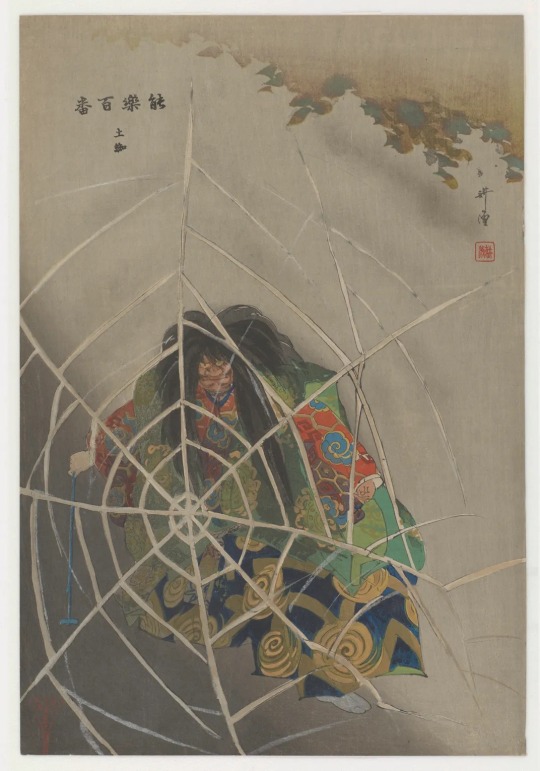
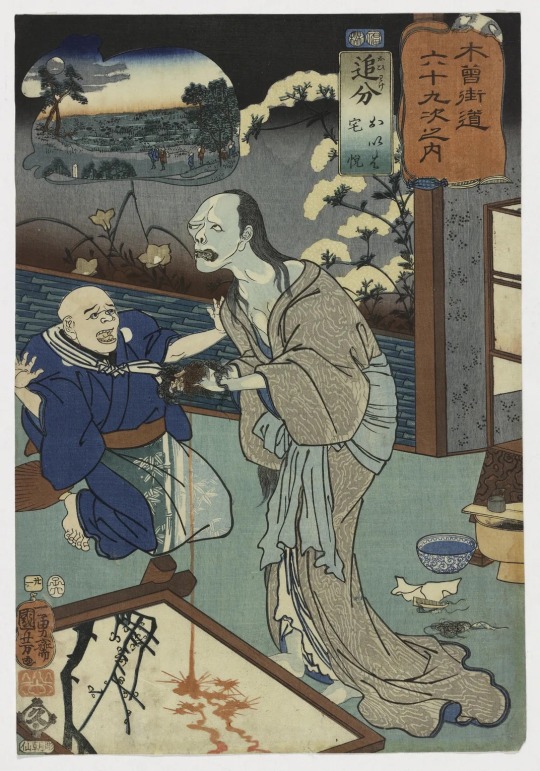
Left: Tsuchigumo, from Prints of One Hundred Noh Plays (Nogaku hyakuban), Tsukioka Kogyo, woodblock print, 1922-1925 National Museum of Asian Art Right: Oiwake: Oiwa and Takuetsu, Utagawa Kuniyoshi, woodblock print, 1852 Oiwake: Oiwa and Takuetsu, no. 21, from the series Sixty-Nine Stations of the Kisokaido Road, Utagawa Kuniyoshi, woodblock print, 1852 National Museum of Asian Art
Kabuki, which originated in the Edo period, was known for its stylized performances and intricate special effects that made it a popular entertainment for broad audiences.
“Whether it was tricks on the stage in terms of trap doors, lots of props, synthetic blood, contraptions that would have characters on wires, flying through the theater—these things were obviously conveying the presence of ghosts,” Brooks says.
Productions featured “spirit flames,” or fire that indicated the presence of ghosts. “Kabuki is very overtly entertaining in terms of bombast,” Brooks says.
Thousands of prints were created and made available at surprisingly populist prices. In the 1840s, Brooks notes, someone could buy a single-sheet multicolor woodblock print for the price of a noodle lunch.
Such colorful, vivid examples rarely survive after nearly two centuries, especially the prints that involved paper flaps that lift up, meant to reflect complicated stage effects.
One such elaborate woodblock print in the exhibition, made in 1861 by Utagawa Kunisada, shows the body of Oiwa pulled to the surface with a fishing hook and, by raising the flap, the body of a second corpse, a servant whose fingernails kept growing after his death.
This trick is even more effective onstage, since both corpses were portrayed by the same actor, doing a quick costume change.
By the 1860s, the stage trick had been used for nearly 40 years, and in that decade, real water tanks were used onstage. Brooks says prints were created to commemorate the trick. The prints are rare, especially those that survived fully intact.
Ghosts had also been prominent in noh theater going back centuries and aimed at a more elite, discerning audience.
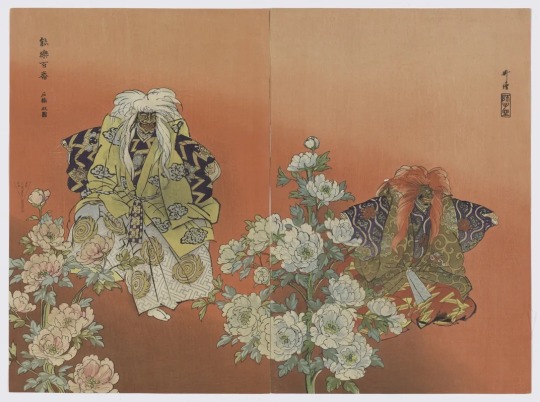
Shakkyo, from the series One Hundred No Plays, Tsukioka Kogyo, woodblock print, 1922-1927 National Museum of Asian Art
Noh started in the 14th century “but dates back much earlier to harvest rituals and entertainments at shrines and temples,” says co-curator Frank Feltens. Those rituals involved dances, chants and characters using elaborate wooden masks. Donning a mask meant “you are basically assuming not just the essence of that role—you’re becoming it,” he says. “It’s a kind of spirit transmission that happens for them.”
Noh may have died out, Feltens says, had it not been revived as a cultural currency when Japan was reinventing itself in the mid-19th century as a more modern nation-state.
The 19th-century woodblock artist Tsukioka Kogyo tapped into the growing interest in noh by not only documenting its fearsome characters, but also clearly indicating the actors beneath the masks to the point of creating behind-the-scenes images of the theater for the first time.
“This peeking behind the scenes is almost sacrilegious in a way because it takes the mythology of noh away,” Feltens says.
Noh stories may not have been as bombastic in ghostly reproductions as kabuki, but the form was instead “capturing stories of the distant past, and those stories are often associated with specific sites, specific locales scattered throughout Japan,” he says.
Those stories are told through spirits associated with the sites, and the spirits are conduits for local memory, he adds.
So why have ghosts endured in Japanese cultural traditions, and why the big revival in the Edo period?
Collector Pearl Moskowitz, who, along with her husband Seymour Moskowitz, gifted hundreds of prints to the museum, posits in the exhibition catalog that it may have been a way to reflect society in a changing time. “My guess is these tales of ghostly hauntings acted as forms of justice in a feudal society in which the authority of the ruling class was absolute,” she writes in her essay.
In such an unjust class system, “it was kind of a catharsis in watching these kinds of plays where ghosts could take vengeance in ways they weren’t able to, and get justice achieved through these revenge plots in a way that might have been very satisfying,” Brooks says. “And samurai were often villains in these stories as well, so that lent some credence to that theory.”
It’s difficult to know how many prints were made at the time, Brooks says, adding that people still make them with traditional methods, and a practitioner could make 200 in a morning.
Viewers can likely connect these images of specters to modern Japanese horror in films like 1998’s Ringu, and its English-language remake, 2002’s The Ring.
“Japanese ghosts are things that people know from Japanese horror films,” Brooks says. “So even if they’re not specialists in the subject, you can still see things that you’d recognize and be interested in.”
Originally set to open around Halloween in October 2023, the exhibition was postponed for almost six months following the discovery of a leak in a nearby stairwell.
“Even though nothing was in danger, you obviously have to have an overabundance of caution, so we took everything out,” says Brooks. “It meant the second installation went very, very fast.”
“Staging the Supernatural” will run until early October at the National Museum of Asian Art—closer to the Halloween connection it was denied last fall.
But people are encouraged to also contemplate the supernatural in the summer. “In Japan, summer is the ghost time period,” Brooks says. “People tell ghost stories in the summer because it’s hot and sweaty and humid, and they make you shiver, which makes you cold.”
— Roger Catlin | Washington, D.C. freelancer Roger Catlin has written about the arts for AARP The Magazine, The Washington Post and other outlets. He writes mostly about TV on his blog rogercatlin.com.
#Japan 🇯🇵#Images of Ghosts#Endured#Exhibition | National Museum of Asian Art#Haunting | Colorful Woodblock | Prints#Smithsonian | Magazine
2 notes
·
View notes
Note
What about the clubs? Not every character in them, but the groups as a whole
Hang on lemme google the clubs again
Cooking club: The cooking club gets extra credit for their involvement. They’re kind of exclusive: kids with bad reputations are not allowed in their club. They’re otherwise the same- pretty tight knit, very positive, and they have a lot of respect for Amai.
Drama club: Only describes the students who engage in the drama program year round and not just during show season. Some of the members are very hardcore and look down on people who won’t engage year round (such as Kizana and, to a lesser extent, Tsuzuro). As of 2019 (when my rewrite takes place), they are performing Yotsuya Kaidan, one of the most influential Japanese ghost stories of all time. They’re not very close- in fact, they tend to be quite competitive, even though they do bond during production.
Occult club: A religious group with a focus on spiritualism. Believes the school is haunted or at least has some kind of a negative energy. (They are right.) Most of the occult club has decent reputations, but due to the stigma around their religious practices, they aren’t fully trusted. They’re quite tight-knit, and a bit like a coven of witches.
Art club: The art club has a pretty good reputation among the school because their art is used for the clubs and programs at school’s promotional posters, which livens the atmosphere of the school. It’s fun by Shoku (cooking club temp leader)’s little sister Geiju, who has presented masc/androgynous for enough of his life that people have kind of forgotten he’s a girl (butch he/him lesbian). Geiju is a little weird, but he’s well liked anyway. He has no reservations against having disliked students in his club, unless they show a disrespect for art.
Light music club: Well, if Miyuji’s bandmates don’t like you, you’re not getting in, but even if you’ve never looked at a musical instrument in your life, Miyuji has no reservations about letting people in. She has a sort of “the more, the merrier” view of it. The band as it is is pretty close, but they’re also very welcoming and will take new members under their wing without a fuss. They get on well with some of the other alt kids at school (like the gyarus- especially Hoshiko, who’s rokku gyaru- and the occult club). If Miyuji doesn’t like you, word will spread among the other alt students.
Martial arts club: It’s kind of the same, but Masato (Budo, club leader) had more of a complex about having to be a teacher to everyone. This is what drove Emiri (Raibaru) away from the club: when she stepped down as leader, she was planning to stay, but it strained her relationship with Masato because he suddenly felt totally responsible for her. Generally respected.
Photography club: Mostly photographs scenery. Will photograph whatever people want for a price. Frequently commissioned by info-chan, despite her also finding them a massive nuisance. They find it necessary to find proof of every rumor. From a gameplay standpoint, they would be an easy way to bully a student- gossip to them and let them find the proof.
Science club: The roomba is their pet. They named it wan-chan (essentially they call it “doggy”). They’re less deranged mad scientists and more a group of total nerds. Mostly computer scientists. Yaku is either a TV head kid with a working screen or a protogen furry. Either way I think he made the screen himself and he’s not allowed to wear either to school so he settles for that visor.
Sports club: Don’t care about these people. To be frank I always forget they exist.
Gardening club: Uekiya is kind to everyone, but I figure she’d probably also not allow club members with bad reputations.
Gaming club: Also a bunch of massive nerds. Actually an e-sports team and compete nationwide. They’re also pretty competitive, but in a friendly way. That being said, they’re not really close, and new members fit in about as well as anyone else.
Delinquents: Were bullied in middle school and adopted the delinquent persona to protect themselves, but they are an outright criminal gang. In the game, Sakyu says that they protect bullied students, but not only do we never see this, they actually do the opposite: they physically harass and assault classmates for getting too close to them, berate and insult everyone who passes by, and when Ayano tries to become their friend, they assume it’s because she’s being bullied and needs help, and they ridicule her for it. I would lean into this: the delinquents became your stereotypical boy bullies to protect themselves against bullying. The bullying thing is something I’ll get into in a sec.
Student council: An entirely formal relationship. They’re very hard on new members.
Gyarus: A group of social but highly defensive and combative girls. All of them having been bullied for their styles (as well as Kashiko for being half black, Hoshiko for her weight, and Kokoro for being trans), they’re quick to become defensive against others. They’re VERY tight knit and bordering on a polyamorous relationship of some kind. It would take a lot to fully fit in with them. They beef a lot with the delinquents.
Clubless students: Hosho, Hazuki and Otohiko (Horuda, Hazu and Otohiko) stick together mostly because they’re all really shy and bullied students. Hosho hangs around the art club, but is too shy to draw, Hazuki likes sewing, but the only other seamstress in school is Ayano, and Otohiko I feel likes crossword puzzles a lot which is a very niche thing to like. All of them are very forgiving of students with bad reputations- Otohiko has a reputation as an easy target, Hosho as a freak and a creep, and Hazuki as an unsocialized weirdo. Toga and Kyuji are not really friends with them, but they’re all kinda at the same spot in life, so there’s some solidarity there. Kyuji and Toga are kinda close, though.
The rainbow kids: they’re there! In my rewrite :) Yui and Haruto are lowkey bullies.
As for the bullying thing, I think it’s been mentioned that in the main game, there’s supposed to be 5 levels of bullying so here’s what I imagine that like. Most groups engage in the bullying, all feeling justified in doing so. Content warning for increasingly more traumatic bullying.
Level 1: Students start gossiping. The gyarus will cut the victim off if they were friends and the delinquents will become more aggressive. The photography club will look for proof that the rumors are true. Domino effects will begin among friend groups- one student dislikes the victim, which makes their friends dislike them, which makes their friends dislike them. The victim will be removed, if applicable, from the gardening or cooking club.
Level 2: The victim will be removed from any clubs. They will begin getting pranked and having their belongings stolen. Notes will be left in their locker.
Level 3: Bullies will begin interacting with the victim physically: classmates will push them out of the way and trip them, delinquents will threaten them, etc. They will begin to write on their desk.
Level 4: Bullying turns physical. Delinquents will beat the victim if they see them.
Level 5: At this point, the victim will withdraw from school or worse.
0 notes
Text
Fridio Yotsuya 3-chome



Arakicho is a valuable traditional drinking area that has not yet become so touristy. You have the Ministry of Defense, Women's Medical College, and a short distance away, Sophia University and Keio Hospital. In summer, there is also the Yotsuya Ghost Story. 82.9 million yen, built in 1997 Toei Shinjuku Line Akebonobashi Sta. 3 min. 51m2 1LDK 14th floor
https://www.homes.co.jp/mansion/b-1231900025233/
0 notes